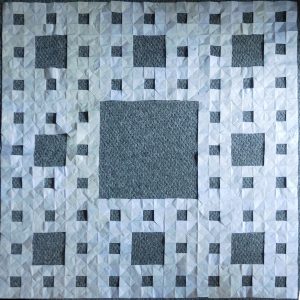Abstract: For the Image Conference Exhibition I would like to show one piece consisting in an origami formed with 4096 squared pieces of white tissue papers assembled and stapled together. These pieces form a 2-dimensional origami work with the shape of a squared Sierpinski Carpet of 135 x 135cm dimensions. For the installation it should be hanged on a wall, as it is typically done with paintings or drawings. Because is extremely light, a double side tape would be enough to support its weight on the wall.
Keyword set: Fractal geometry; Origami; Sierpinski Carpet
Knowledge focus: This handmade paper fractal aims at celebrating this mathematical model. Fractal geometry was formalised in 1975 by Benoit B. Mandelbrot. It extended classical Euclidean geometry, which dominated Western scientific and philosophical thinking for centuries. The fractal model mirrors distinctive features of natural formations, which are rough, broken and irregular. A fractal is a coarse and fragmented geometric form that can be eternally divided into smaller pieces. It is a self–similar, iterated and detailed mathematical construct that presents a singular interrelation between the wholes and the parts composing it. Every unit in a fractal can equally correspond to a whole and to a part of a bigger whole simultaneously. Because the fractal function is an iterative and recursive formula, it was not until the arrival of computers that fractal geometry was transformed into a science. Computers’ extraordinary capacity was needed in order to exploit its full potential, and to literally “see” and test concrete possible applications of this function.
